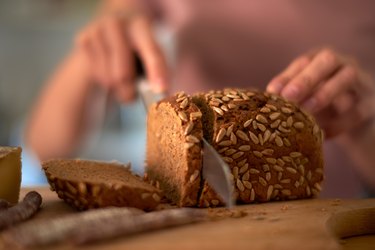
Whole-grain bread and its whole-grain cousins have achieved almost holy status in a world grappling with obesity. It's true: Whole grains are definitely the go-to carbohydrates when it comes to managing and preventing type 2 diabetes and heart disease as well as losing and maintaining weight.
For instance, white bread is more closely associated with belly fat, which in turn, is linked with a higher risk of heart disease, type 2 diabetes and liver issues, according to a July 2015 study published in the Journal of British Nutrition.
Video of the Day
Video of the Day
But white bread, despite obvious drawbacks, still has its time and place. Here, a look at exactly how white bread is digested, along with what can happen when you eat a slice.
How White Bread Is Digested
Digestion of proteins, fats and starch really start when you chew, but because white bread is high in starch, most of the digestion takes place in the small intestine, an organ which includes the ileum, jejunum and the cecum.
There, enzymes break the white bread down into glucose monosaccharides — the simple sugars which are products of digestion. Glucose is then quickly absorbed into the blood stream where it's either used as energy for the cells or stored in the fat for use later.
By contrast, whole-grain bread contains a lot of fiber which is digested by the large intestine, not the small intestine. That means digestion time is longer. As a result, whole-grain bread doesn't spike your blood sugar as quickly or as much as white bread, per a 2016 report from the British Nutrition Foundation.
Whole-grain products also keep you feeling full longer, according to the report, which reviewed a number of studies.
White Bread Nutrients vs. Whole-Wheat Bread
Many of the nutrients you find in whole-grain breads are missing in white bread because of the way it’s processed.
“White bread is usually made from refined flour so it goes through a milling process,” explains Roxana Ehsani, RD, a spokesperson for the Academy of Nutrition and Dietetics. “The bran and germ which contain fiber and healthy fat are stripped away. Only the starch part remains and that’s low in nutritional value.”
Per the Whole Grains Council, after refining, all-purpose refined flour retain only 25 percent of the fiber available in whole-wheat flour, 8 percent of vitamin E, 11 percent of vitamin B6, 33 percent of iron and 59 percent of folate.
The Effects of White Bread on Digestion
1. It Makes Blood Sugar Spike
Because it is digested so quickly and tends to dramatically increase blood sugar levels, white bread typically is not a good choice for weight control and for preventing and maintaining different chronic conditions.
Take diabetes. "People with diabetes need to be a little more cautious," Ehsani says. "We're not saying don't have it ever but pair a carb with a protein, for example and egg or peanut butter."
White bread works against stable blood sugar levels, increasing the risk of complications such as heart and kidney disease in the future.
In contrast, eating whole grains may help reduce the risk of developing type 2 diabetes. For instance, people who ate at least one serving of whole grain products a day were 29 percent less likely to develop type 2 diabetes than those who ate less than one serving a month, according to a July 2020 study published in BMJ.
2. It Could Cause Constipation
Because it contains no fiber, white bread doesn't prevent constipation. "It definitely can cause constipation in people and Americans as a society are not eating enough fiber," Ehsani says.
Fiber adds bulk to your poop and makes it easier to move out of your body. In addition to whole grains, fruits and veggies are a great way to get more fiber.
2. It Can Help With Digestion
Here's the funny thing about fiber: Even though it can help keep you regular and aid your digestion, adding a lot of fiber to your diet quickly can also lead to GI distress, including cramping, gas and bloating, per the Mayo Clinic.
That is, fiber-rich foods can sometimes be hard for your body to digest — eating a hearty, high-fiber bread could leave you with stomach pain. Not so for white bread. "It's beneficial for anyone with a queasy stomach," Ehsani says. "It's easy to digest and it's not going to upset your stomach."
White bread can be helpful if you have:
- Irritable Bowel Syndrome (IBS): This refers to a group of symptoms that affect your digestive system. "A person with IBS may have intense episodes of diarrhea and constipation," Ehsani says. 'That's when you can reach for white bread."
- Inflammatory Bowel Disease (IBD): IBD includes two conditions, ulcerative colitis and Crohn's disease, which involve inflammation of the digestive tract. White bread can be beneficial for someone with IBD when episodes of diarrhea or constipation worsen, says Ehsani.
- Diarrhea or constipation: You don't have to have IBS or IBD to benefit from white bread. It can ease your stomach when you experience diarrhea or constipation.
- Heartburn: White bread is less likely to lead to the excess acid production which causes heartburn, also called acid reflux.
Plus, because it's so easy to digest, white bread can be helpful for endurance. "Athletes need to have easy carbs as a source of fuel," Ehsani says. "I recommend white bread as a great source hour before game time or practice. It's a quick source of easy-to-digest fuel before exercise."
To Toast or Not to Toast?
Toasted white bread may actually have benefits regular white bread does not. “When we toast it, it loses some of its moisture,” Ehsani says. “For some people, toasted bread can be digested easier because toasting breaks down starches.”
If you undergoing cancer treatment, recovering from a stomach virus or have another condition that's causing changes to your appetite or nausea, you may try the BRAT (banana, rice, applesauce and toast) diet, which limits any bread with more than 5 grams of fiber per serving, per Memorial Sloan Kettering Cancer Center.
And toasting doesn’t really change the nutrient content.
The U.K. Oesophageal Patients Association, which represents people with esophageal and gastric trouble, includes toast as the first item on a list of easily digestible foods.
4. It Could Trigger Reactions to Gluten
People with celiac disease have an immune reaction to gluten, a protein found in many breads, including white bread.
"Gluten can cause a lot of gut complaints in people with celiac disease, like abdominal cramping, diarrhea," Ehsani says. "Some people get constipation or even nausea." If you have celiac disease, you should avoid any bread or other products which contain gluten.
- British Journal of Nutrition: “Relationship between bread and obesity”
- University of Texas Southwestern Medical Center: “Why belly fat is dangerous and how to control it"
- Whole Grains Council: “Myths Busted: Why White Bread Is NOT Just as Healthy as Whole Grain Bread”
- British Nutrition Foundation: “A summary of evidence on the digestion, absorption and metabolism of white bread carbohydrates”
- Food & Function: “On the possibility to affect the course of glycaemia, insulinaemia, and perceived hunger/satiety to bread meals in healthy volunteers”
- Appetite: “Wholegrain vs. refined wheat bread and pasta. Effect on postprandial glycemia, appetite, and subsequent ad libitum energy intake in young healthy adults”
- Food Structure: “Kernel structure in breads reduces in vitro starch digestion rate and estimated glycaemic potency only at high grain inclusion rates”
- BMJ: “Intake of whole grain foods and risk of type 2 diabetes: results from three prospective cohort studies”
- Mayo Clinic: “Celiac disease”
- American Diabetes Association: “Get to Know Carbs”
- National Council on Aging: “Why It's Important to Eat Healthy When You Have Diabetes”
- Harvard T.H. Chan School of Public Health: “Carbohydrates and Blood Sugar”
- National Institute of Diabetes and Digestive and Kidney Diseases: “Irritable Bowel Syndrome (IBS)”
- Oesophageal Patients Association: “11 foods that are easy to digest”
- Mayo Clinic: "Dietary fiber: Essential for a healthy diet"
- Mayo Clinic: "Mayo Clinic Q and A: Increasing fiber intake for constipation relief"
- Memorial Sloan Kettering Cancer Center: "Bland or BRAT Diet - What It Is"
- U.S. National Library of Medicine: "When you have diarrhea"
Is this an emergency? If you are experiencing serious medical symptoms, please see the National Library of Medicine’s list of signs you need emergency medical attention or call 911.


